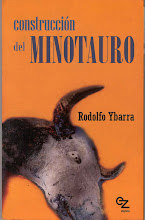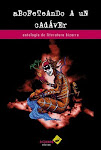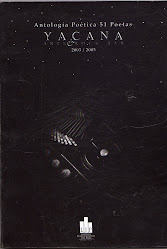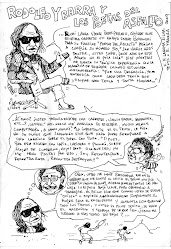El Manifiesto Abomunista translated by Zachary de los Dolores Review by Estíbaliz Encarnación-Pinedo El Manifiesto Abomunista translated by Zachary de los Dolores Review by Estíbaliz Encarnación-Pinedo
I. Introduction Almost seventy years after the murder of David Kammerer by Lucien Carr, an event marked by many as the beginning of the Beat mythology, the influence of the Beat Generation is still growing. New studies are published every year, many of which reshape the movement and expand its borders by including previously overlooked authors. Even in Hollywood Beat stories have recently occupied centre stage; Epstein’s Howl (2010), Salles’s On the Road (2012), Polish’s Big Sur (2013) and Krokidas’s Kill your Darlings (2013) are proof of this increasing interest in the Beat Generation. Unfortunately, the sphere of influence is severely hindered by the language barrier, which has prevented, for example, a similar impact on Spanish culture and Spanish readers. For those for whom reading the original works in English is not an option, the number of Beat works available is drastically reduced. In addition, the prevalence of the triumvirate of Kerouac, Ginsberg and Burroughs becomes more apparent in this case, since these are the authors whose works have predominantly – and yet still very scarcely – been translated into Spanish. Zachary Payne’s book taps into this gap directly. Firstly, by offering the first translation into Spanish of Bob Kaufman’s Abomunist Manifesto and, secondly, by placing under the spotlight an author who has predominantly remained – even if voluntarily – on the periphery of the movement. While on the whole the translation goes smoothly, and is very faithful to the original, there are a few instances in which different decisions might have created a greater impact on Spanish readers, getting them closer to the experience of the original text. In any case, Payne’s effort to locate Kaufman’s work first within the Beat movement, and secondly in relation to other counterculture literary movements, makes this book a much-needed and valuable contribution to the Spanish-speaking literary market in general, and to Beat Generation studies in particular.
II. Summary Bob Kaufman’s Abomunist Manifesto, first published in 1959, has been described as an “anarcho-surreal parody of all the –isms,”1 and follows Kaufman’s spontaneous, orally-based poetry composition present in other works. If we add to this the rhythm and jazz-like musicality emphasized with the repetition of lines, as well as the language disruptions and inventions – the poem even includes its own lexicon – the already complicated process of translation becomes an epic task. Zachary Payne manages to translate the poem skillfully, overcoming – even if occasionally sacrificing meaning– the difficulties the original text presents. In addition to the translation of the poem, Payne includes two texts that frame Kaufman’s work within literary discourses. The first one, which takes the form of a foreword to his translation, is a letter Payne writes to the poet in which he introduces Kaufman’s work and places him in the literary context in which he wrote. The second one, with which he concludes the book, is an interview in which he unites the Beat Generation with the Nadaista and the Kloaka South-American literary movements.
III. Critique One of the first obstacles which a translator encounters when dealing with Kaufman’s Abomunist Manifesto is its language. Taking the form of a fake-manifesto, the poem constantly mocks – both through the use of invented language and through its form itself – the supposedly serious, almost sacred, nature of such manifestos. As Stephenson notes, the Abomunist Manifesto exposes “to laughter the preposterously solemn jargon and cant characteristic of established religion, academia, artistic and literary manifestos, and political ideologies.”
2 The translation process exposes the linguistic and cultural difficulties raised by a complex poem such as Kaufman’s, as well as the different strategies used by the translator in order to overcome them. An example of the difficulties the text presents is the translation of the term “frink,” which in the lexicon included in the poem is defined as “[t]o (censored). n. (censored) and (censored).” In his Spanish translation, Zachary Payne decides to keep the original term, highlighting it through the use of italics, and including a footnote directing the reader towards the lexicon. With such techniques, Payne is drawing attention to the original, avoiding the domestication of a text that already has foreign elements in its original form. Although this way he avoids translating a rather untranslatable word, other changes might have been added to the translation in order to be more faithful to the original. Looking at the lexicon included in the original poem, one can appreciate how the word “frink” – initially used as a verb – allows suffixes so that it is also used as a noun, adjective and adverb in the original poem, just as it is inflected when it is a verb depending on the tense and subject. In Payne’s translation, instead of keeping the original “frinky,” for example, when translating the word as an adjective, an equivalent Spanish suffix to infer the notion of grammatical correspondence might have been added, even if the term does not exist per se. Similarly, in cases in which “frink” is used as a verb – “[w]e then ate two pounds of garlic bread & frinked” – endings could have been added to the stem in order to keep concordance and to highlight, at the same time, the absurdity of language and its conscious construction in manifestos and other official documents. That Payne opted to leave the original terms in these cases is rather surprising, since he does translate the suffix in words like “frinkism,” translated as “frinkismo,” but keeps the original when translating “frinkage” in the “Abomunist Election Manifesto”. Transforming the suffixes into Spanish equivalents would enable readers to get closer to the experience of reading the original. A radically different case is found in the section “Abomunist Rational Anthem”, a song allegedly composed by Schroeder, which could be a reference to the Peanut comic strip character, and whose lyrics are entirely based on invented words. On this occasion, Payne opts for leaving the poem as it is in the original. Although, as Damon states, “it is possible to decode this poem to some degrees […] the point is not to do so, but to experience the disorientation of babble which, at the same time, like jazz argot, encodes protest.”3 Even if one could have tried to make the words sound more “Spanish” in the translation, it would be an unnecessary effort, since the poem’s strength lies in the juxtaposition between the “rational” of the title, and the irrationality of its content, which is retained in Spanish by simply keeping the original wording. Another aspect that needs to be taken into account when translating a text, and which translation theories have emphasized in recent decades, is the role played by the culture intrinsic in texts. Especially in literary or social texts, it is evident that more than just decoded semantics and grammar is required: translators need to translate from one culture into another. In Kaufman’s poem, this issue is particularly noticeable in the section “Abomnewscast…on the Hour…,” the satirical and ironic newscast full of cultural and political references. Although, unlike Nabokov, I do not necessarily agree with the need for “translations with copious footnotes,”4 when dealing with poetical texts, I believe it is a necessary technique in some cases. For example, it is very unlikely that a contemporary Spanish-speaking reader would be familiar with the kidnapping and murder of Charles Augustus Linderbergh Jr., son of the famous aviator Charles Linderbergh. Therefore, the irony behind Kaufman’s piece of news stating that “America collides with Iceberg piloted by Lindbergh baby…” is lost without the background information. Similarly, references to Leopold and Loeb’s crime or Norman Rockwell’s illustrations, make the reception of this news dependent on the readers’ pre-existent knowledge. Just as on other occasions Payne uses footnotes to explain counterculture concepts such as “square” or “cat,” as well as food and beverages common in North America such as “butterscotch,” “root beer” or the cereal brand “shredded wheat,” Spanish readers might have also benefited from a few explanatory footnotes on this section. On the whole, the original text is very present in the translation; the presence of Bob Kaufman is highlighted, which I think is Payne’s main concern. In addition, this move carries greater significance if we bear in mind that this text might be the introduction to Kaufman’s work for many Spaniards or Spanish Americans. However, at times the text feels a bit under-translated, as there are some instances in which the author keeps English terms instead of using available Spanish equivalents – “popcorn,” instead of “palomitas,” or “sketchs,” instead of “bocetos.” Likewise, in order to be more faithful to the original, the apparently random capitalization of words in the “Abomunist Documents” section should be kept in the translation or, at least, be consistent with the decisions taken – i.e., keep all capitalizations or none of them. These, together with minor spelling mistakes and typographical errors that should be corrected for a second edition, represent the less attractive side of a rather good book. Perhaps more interesting than the purely linguistic or stylistic analysis of Payne’s Spanish translation, are the paratexts with which he accompanies the poem, particularly the interview with Eduardo Escobar and Roger Santiváñez, two landmarks from Nadaísmo and Kloaka South-American literary movements. The scene where the interview takes place is beautifully introduced with a preamble in which Bob Kaufman himself is brought back to life, jumping and hypnotizing those willing to really listen to his poetry in a bar. In this magical context, Payne’s “traslación”5 – as Rodolfo Ybarra aptly calls it in the countercover of the book – takes full power. Linking these three literary movements by their “rejectionary” – in the Abomunist argot – spirit, as well as by their need to rebel and react against different systems of oppression, Payne uses this interview to highlight the shared influences and connections between the movements. Rather than simply stating these connections, though, the idea which prevails is that they share the same creative energy, and that that energy translates into their work, generation to generation, without their being conscious of it.
IV. Conclusion In the letter with which Zachary Payne introduces his translation of Bob Kaufman’s Abomunist Manifesto, he acknowledges the problems which arise in poetical translation, stating that he may have lost, in the course of translation, the musicality and jazz of Kaufman’s verses. However, as he also comments in the letter, it is Kaufman’s exclusion from Beat history that prompted him to go against the author’s wish to be forgotten. Through this book Payne manages to keep Kaufman’s spirit alive, sharing his genius with a public that might otherwise have been oblivious to him. Even if there are a few aspects that could be improved, I believe that, ultimately, the “rough edges and awkwardnesses,”6 as fellow Beat poet Diane di Prima described her experimental book The Calculus of Variation, should not be analyzed as mistakes, or as issues to fix, but as examples of the dialogue that is created between the two authors and languages. It is not just the transfer from one language to another, but a learning experience created through the links between Kaufman’s poetry and other literary movements, as well as Payne’s position as a poet and scholar himself. In addition, as a non-native Spanish speaker who speaks “butterfly,” rather than a grammatically correct Spanish, Payne captures the rebelliousness and spontaneity of the Beat ethos. It is in the meeting point of all of these factors that Payne’s El Manifiesto Abomunista best celebrates and serves as a tribute to Kaufman’s work. 1. [A. Robert Lee, “Black Beats: The Signifying Poetry of LeRoi Jones/Amiri Baraka, Ted Jones and Bob Kaufman,” in A. Robert Lee, ed., The Beat Generation Writers (London: Pluto Press, 1996), 171.]↩ 2. [Gregory Stephenson, Pilgrims to Elsewhere: Reflections on Writings by Jack Kerouac, Allen Ginsberg, Gregory Corso, Bob Kaufman and Others (Aalborg: EyeCorner Press, 2013), 29.]↩ 3. [Maria Damon “Abomunist Manifesto,” in Kurt Hemmer, ed., Encyclopedia of Beat Literature (New York: Infobase Publishing, 2007), 2.]↩ 4. [Vladimir Nabokov, “Problems of Translation: Onegin in English,” in Rainer Schulte and John Biguenet, eds., Theories of Translation: an Anthology of Essays from Dryden to Derrida (Chicago: University of Chicago Press, 1992), 143.]↩ 5. [The term “traslación” highlights the movement from the original author/text to the translator/translated text, drawing attention to transfer from one literary context to the other.]↩ 6. [Diane di Prima, Recollections of My Life as a Woman: The New York Years (New York: Penguin Books, 2002), 384.]↩
El Manifiesto Abomunista Traducido por Zachary de los Dolores Crítica de Estíbaliz Encarnación-Pinedo
I. Introducción Casi cuarenta años después del asesinato de David Kammerer a manos de Lucien Carr, un evento que figura con frecuencia como el inicio de la mitología Beat, la influencia de esta generación sigue creciendo. Por ejemplo, cada año se publican nuevos estudios que revisan y amplían el movimiento al incluir nombres de autores desconocidos. Incluso Hollywood ha mostrado un reciente interés en historias Beat: Aullido (2010) de Epstein, En la Carretera (2012) de Salles, Big Sur (2013) de Polish, y Kill your Darlings (2013) de Krokidas, son un ejemplo más del creciente interés en la Generación Beat. Desgraciadamente, la ola de influencia se ve frenada por la barrera del lenguaje, que ha dificultado un impacto similar en la cultura hispano-hablante y en sus lectores. Para aquellos a los que no les sea posible leer las obras originales, el número de obras Beat disponibles se ve muy reducido. Además, es en estos casos en los que el triunvirato Kerouac, Ginsberg y Burroughs se hace más evidente, ya que estos son los autores que se han traducido al español más a menudo, aunque todavía con reservas. El libro de Zachary Payne se sumerge de lleno en esta laguna. Primero, al ofrecer la primera traducción al español del Manifiesto Abomunista de Bob Kaufman y, segundo, al hacer visible un autor que ha permanecido (aunque puede que de manera voluntaria) en la periferia del movimiento Beat. Aunque por lo general la traducción es muy fluida y fiel al trabajo original, hay ciertos aspectos que de haberse beneficiado de decisiones distintas podrían haber tenido un mayor impacto en los lectores españoles, acercándolos más a la experiencia del original. En cualquier caso, el esfuerzo que hace Payne por situar el trabajo de Kaufman tanto dentro de la Generación Beat, como en relación con otros movimientos literarios de contracultura, hace de este libro una contribución necesaria y valiosa para el mercado literario hispano-hablante en general, y para el estudio de la Generación Beat en particular.
II. Resumen Publicado por primera vez en 1959, el Manifiesto Abomunista de Bob Kaufman ha sido descrito como una “[p]arodia anarco-surrealista de todos los –ismos7,” y es ilustrativo de la poesía espontánea y oral también presente en otras obras del mismo autor. Si a esto le añadimos el ritmo y la musicalidad del jazz que se hace sentir en las repeticiones de versos, junto con las disrupciones del lenguaje (el poema incluye su propio léxico), el proceso de traducción, ya de por sí complicado, se convierte en una tarea épica. Zachary Payne consigue traducir el poema con gran habilidad, superando (aunque se renuncie en algunas ocasiones al significado), las dificultades que el texto original presenta. Además de la traducción del poema, Payne incluye dos textos que enmarcan el trabajo de Kaufman dentro de otros discursos literarios. El primero de ellos, que actúa como preámbulo de la traducción, es una carta en la que el autor se dirige al poeta, y presenta su trabajo dentro del contexto literario en el que escribió. La segunda, con la que se concluye el libro, es una entrevista en la que se relaciona la Generación Beat con los movimientos literarios Sudamericanos Nadaísta y Kloaka.
III. Evaluación Uno de los primeros obstáculos con los que se topa un traductor al enfrentarse al Manifiesto Abomunista de Kaufman, es su lenguaje. Con forma de un falso-manifiesto, el poema se mofa, a través de lenguaje inventado y de su misma estructura, de la supuesta naturaleza sagrada de este tipo de documentos. Como comenta Stephenson, el Manifiesto Abomunista se “mofa de la risible y supuestamente solemne jerga y palabrería característica de la religión establecida, mundo académico, manifiestos artísticos y literarios e ideologías políticas8.” El proceso de traducción saca a la luz las dificultades lingüísticas y culturales que un poema complejo como el de Kaufman conlleva, así como las diferentes estrategias que emplea el traductor para superarlas. Un ejemplo de las dificultades que presenta el texto es la traducción del término “frink,” que en el léxico incluido en el poema se define como “v. [censurado]. n. (censurado) y (censurado).” En la traducción, Payne decide dejar el término original, destacándolo con el uso de la letra cursiva, e incluyendo una nota al pie de página que dirige la atención del lector al léxico. Con estas técnicas, Payne llama la atención sobre el texto original, a la vez que evita la domesticación de un texto que ya en su forma original tiene elementos extranjeros. Aunque de esta manera se evita tener que traducir una palabra en sí intraducible, con algunas modificaciones se conseguiría un efecto más fiel al texto original. Si se mira el léxico incluido en el poema, se puede observar que el término “frink,” usado por primera vez como verbo conjugable, admite sufijos que lo transforman en nombre, adjetivo e incluso adverbio. En la traducción de Payne, por ejemplo, en vez de dejar el término original, “frinky” cuando la palabra se usa como adjetivo, se podría haber empleado un sufijo adjetival equivalente español para cubrir la correspondencia gramatical, aunque el termino en sí no exista. Del mismo modo, en los casos en los que “frink” se usa como verbo (“[w]e then ate two pounds of garlic bread & frinked”), se puede añadir terminaciones gramaticales para mantener la concordancia y destacar, a la vez, lo absurdo de la construcción consciente del lenguaje que opera en dichos manifiestos y otros documentos oficiales. El que Payne opté por dejar el término original en estos casos sorprende, ya que sí traduce el sufijo en palabras como “frinkism,” que traduce como “frinkismo,” pero decide dejar el término original en el caso de “frinkage,” en la sección Manifiesto Electoral Abomunista. Usar sufijos equivalentes en español facilitaría la lectura, haciendo que los lectores se acerquen a la experiencia del texto original. Un caso radicalmente distinto es el que encontramos en la sección Himno Racional Abomunista, una canción supuestamente compuesta por Schroeder, que puede ser una referencia al personaje de la tira cómica Peanuts, y cuya letra está totalmente formada por palabras inventadas. En esta ocasión, Payne decide dejar el poema tal y como está en el texto original. Aunque como Damon dice, “es posible decodificar el poema hasta cierto punto […] el objetivo es no hacerlo, si no experimentar la desorientación del balbuceo que, a la vez, como la jerga del jazz, lleva protesta codificada.9” Aunque se hubiera podido transformar las palabras para que suenen más naturales en español, es un esfuerzo innecesario, ya que la fuerza del poema reside en la yuxtaposición entre lo “racional” del título, y la irracionalidad de su contenido, que se mantiene en el texto español simplemente dejando las palabras del original. Otro aspecto que se debe tener en cuenta al traducir, y que teorías de la traducción han enfatizado en las últimas décadas, es el papel que juega la cultura que se encuentra de manera intrínseca en los textos. Especialmente en textos literarios y sociales, se pone de manifiesto que más allá de la semántica y gramática, traducir significa hacerlo de una cultura a otra. En el poema de Kaufman, este aspecto cobra mayor importancia en la sección “Abomnoticiero…en Hora Punta…,” un noticiero satírico e irónico lleno de referencias culturales y políticas. Aunque, a diferencia de lo que comentó Nabokov, no estoy de acuerdo con la necesidad de hacer “traducciones con copiosas notas a pie de página10,” cuando se trata de textos políticos, creo que se convierte en una técnica necesaria en muchos de los casos. Por ejemplo, es poco probable que un lector contemporáneo hispano esté familiarizado con el rapto y asesinato de Charles Augustus Linderbergh Junior, hijo del famoso aviador Charles Linderbergh. Por eso, sin la necesaria información de contexto, es posible que se pierda la ironía tras la noticia “América choca contra un iceberg pilotado por el niño Lindbergh.” Del mismo modo, referencias al crimen cometido por Leopold y Loeb, o a las ilustraciones de Norman Rockwell, hacen que la recepción de estas noticias dependa del conocimiento previo de los lectores. Del mismo modo que en otras ocasiones Payne utiliza notas a pie de página para hacer aclaraciones sobre términos de contracultura como “square” o “cat,” así como sobre comida y refrescos de consumo más o menos habitual en Norteamérica tales como el “butterscotch,” la “cerveza de raíz” o la marca de cereales “shredded wheat,” los lectores hispanos se podrían haber beneficiado de algunas notas aclaratorias en esta sección. En general, el texto original está muy presente en la traducción, una posición que realza la presencia de Bob Kaufman, lo que considero que es, a su vez, el principal objetivo de Payne. Además, esta posición adquiere un mayor significado si tenemos en cuenta que este libro puede representar para muchos la presentación de la obra de este autor. Sin embargo, también se corre el riesgo de que el texto se vea poco traducido en algunos casos. Esto ocurre, por ejemplo, cuando se mantienen términos ingleses aún cuando existen equivalentes en español, como “popcorn,” en vez de “palomitas”, o “sketchs,” en vez de “bocetos.” Del mismo modo, para ser fieles al texto original, se deberían mantener las mayúsculas que Kaufman incluye de manera aparentemente aleatoria en la sección Documentos Abomunistas o, al menos, se debería ser constante en este aspecto (mantener todas las mayúsculas, o ninguna). Son estos aspectos, junto con algunos errores tipográficos y de ortografía que deberían ser corregidos para una segunda edición, los que representan el lado menos cuidado de lo que es, aún así, un muy buen libro. Quizás más interesante que los aspectos puramente lingüísticos o estilísticos de la traducción al español de Payne, es el paratexto que complementa al poema, especialmente la entrevista con Eduardo Escobar y Roger Santiváñez, dos referentes de los movimientos literarios sudamericanos Nadaísmo y movimiento Kloaka. La escena en la que se lleva a cabo la entrevista está bellamente presentada con un preámbulo en el que el mismo Bob Kaufman cobra vida de nuevo, saltando e hipnotizando a aquellos dispuestos a escuchar su poesía en un bar. Es en este contexto mágico donde adquiere más fuerza la “traslación” de Payne (como la llama con acierto Rodolfo Ibarra en la contraportada del libro). Uniendo los tres movimientos literarios por su espíritu “reaccionario” (en la jerga abomunista), así como por su necesidad de rebelarse contra diferentes sistemas de opresión, Payne utiliza esta entrevista para sacar a la luz las influencias compartidas y las conexiones entre los movimientos. Más allá de la mera unión de estos movimientos, la idea que prevalece es que los tres se nutren de la misma energía creativa, y que es esta energía la que se traduce, generación tras generación, en sus trabajos, incluso sin ser conscientes de ello.
IV. Conclusión En la carta con la que Zachary Payne presenta su traducción del Manifiesto Abomunista de Bob Kaufman, reconoce los problemas que surgen al enfrentarse a una traducción poética. Asimismo, admite la posibilidad de haber perdido, en el proceso de traducción, la musicalidad y el jazz de los versos del poeta. Sin embargo, como también comenta en la carta, es precisamente la exclusión que ha sufrido Kaufman de la historia de la Generación Beat, lo que le llevó a ir en contra de los propios deseos del autor, que en más de una ocasión había comentado que su aspiración era ser olvidado. A través de este libro, Payne consigue mantener vivo el espíritu de Kaufman, compartiendo su genialidad con un público que puede que no le conociera hasta el momento. Aunque hay algunos aspectos que se podrían mejorar considero que, al final, las “asperezas y rarezas11,” como comentaba la también poeta Beat Diane di Prima sobre su trabajo The Calculus of Variation, no se deberían analizar como errores a enmendar, sino como ejemplos del diálogo que se crea entre los dos autores. Más que la mera transmisión de una lengua a la otra, se trata de una experiencia de aprendizaje nacida de las conexiones entre la poesía de Kaufman y otros movimientos literarios, así como de la posición de Payne como poeta y académico. Además, como un hablante no nativo del español, que habla “mariposa12,” más que un español gramaticalmente correcto, Payne consigue capturar en su traducción la rebeldía y la espontaneidad del espíritu Beat. Es en el lugar de encuentro de todos estos factores, donde El Manifiesto Abomunista de Zachary Payne celebra con mayor fuerza y rinde mejor tributo al trabajo de Kaufman.
7. [A. Robert Lee, “Black Beats: The Signifying Poetry of LeRoi Jones/Amiri Baraka, Ted Jones and Bob Kaufman,” in A. Robert Lee, ed., The Beat Generation Writers (London: Pluto Press, 1996), 171. Mi traducción.]↩ 8. [Gregory Stephenson, Pilgrims to Elsewhere: Reflections on Writings by Jack Kerouac, Allen Ginsberg, Gregory Corso, Bob Kaufman and Others (Aalborg: EyeCorner Press, 2013), 29. Mi traducción.]↩ 9. [Maria Damon “Abomunist Manifesto,” in Kurt Hemmer, ed., Encyclopedia of Beat Literature (New York: Infobase Publishing, 2007), 2. Mi traducción.]↩ 10. [Vladimir Nabokov, “Problems of Translation: Onegin in English,” en Rainer Schulte y John Biguenet, eds., Theories of Translation: an Anthology of Essays from Dryden to Derrida, (Chicago: University of Chicago Press, 1992), 143. Mi traducción.]↩ 11. [Diane di Prima, Recollections of My Life as a Woman: The New York Years, (New York: Penguin Books, 2002), 384. Mi traducción. ]↩ 12. [Ver http://asociacionumbrales.blogspot.com.es/2012/05/nuevo-libro-death-del-oso-antologia.html]↩ Leave a Reply Your email address will not be published. Required fields are marked *





































No hay comentarios:
Publicar un comentario